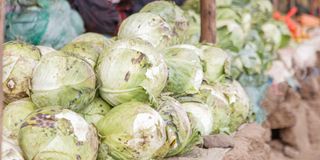Premium
Why cabbage farming is promising

Cabbage, often underestimated, holds great potential for those willing to invest in good agricultural practices and market timing.
Cabbage farming in Kenya has quietly but steadily become one of the most promising ventures for anyone seeking food security and a steady income.
While it has long been associated with the cool, highland areas like Nyandarua, Meru and Molo, farmers in drier regions such as Makueni, Kajiado, Marsabit, Garissa and parts of Machakos are also proving that with proper planning and irrigation, cabbage can thrive just as well in semi-arid zones.
This green leafy crop, often underestimated, holds great potential for those willing to invest in good agricultural practices and market timing.
Cabbage is a fast-maturing crop, with many hybrid varieties taking just two and a half to three months to reach harvest.
This short turnaround time allows farmers to grow multiple cycles in a year if conditions allow, especially where irrigation is available.
With increasing demand from households, schools, hotels and urban markets, cabbage remains one of the most consumed vegetables across the country.
Whether it is served in a simple vegetable stew or accompanying a plate of ugali and meat, cabbage is a staple in kitchens.
Beyond its culinary role, cabbage is rich in important nutrients such as vitamin C, vitamin K and dietary fibre, contributing to better nutrition for families.
But what makes cabbage even more attractive is its market potential. A farmer with good management can harvest 11,000 to 14,000 heads per acre.
The returns can be significant when sold at an average of Sh25 per head. While production costs such as seeds, fertiliser, labour and pest control must be accounted for, the net income often remains favourable, especially if the crop is planted and harvested at a time supply is low.
Cabbage prices tend to rise during dry seasons or during school terms when institutional buyers are most active, making strategic timing a key part of successful cabbage production.
Farmers in drier areas who have invested in drip or furrow irrigation systems are finding that cabbage is not just a crop for the highlands.
With well-prepared land, quality seeds, and consistent water supply, even dryland farmers can produce competitive cabbage harvests.
This makes cabbage a versatile crop that responds well to care and effort.
In fact, the spread of boreholes, shallow wells and water pans has opened new possibilities for cabbage farming in regions that previously relied on rain-fed agriculture alone.
As more farmers explore this opportunity, it is important to approach cabbage farming as a science and a business. From selecting the right variety to managing pests and finding reliable markets, every step counts.
In the coming articles, we’ll take a closer look at every stage of the journey from seed to market to help you make informed decisions, avoid mistakes and grow a successful cabbage enterprise.
With the right knowledge and commitment, cabbage farming could be your next big breakthrough. Let’s grow together.


